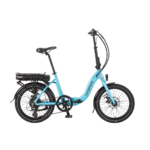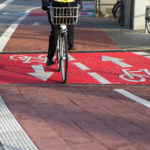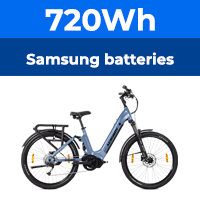In my thread about Dahon conversions, the subject of speed has come up a few times. I've been reading the DirectGov site EAPC regulations for electric bikes. These give a max 200 watts power output & top speed of 15 mph which seems somewhat draconian. Been wondering whether anyone has ever been prosecuted for riding an electric bike which exceeds speed or power regulations? What would be the likely consequence of being caught either through routine inspection or the result of an accident. With some bikes being well over the limit and others only by the odd mph, would this make any difference in the case of a prosecution? Should I worry about riding a bike with a top assisted speed above the 15 mph limit?
Legality & electric bikes. Does speed matter!
- Thread starter homemoz
- Start date
Legally yes it does matter. However most standard kits pill peaks over the 200 or 250w limit. Usually over double.
Also when a battery is fully charged it will usually go overthe legal limit.
Its probably ok as long as you don't have and accident but you can't predict those. So it the accident was anything serious I would imagine the law would come down on you pretty hard. However most police officers have better things to do than pull over a push bike
Silently whizzing past.
Ie motocross bikes and pit bikes and other cheeky monkeys are more of a concern.
Also when a battery is fully charged it will usually go overthe legal limit.
Its probably ok as long as you don't have and accident but you can't predict those. So it the accident was anything serious I would imagine the law would come down on you pretty hard. However most police officers have better things to do than pull over a push bike
Silently whizzing past.
Ie motocross bikes and pit bikes and other cheeky monkeys are more of a concern.
I have never found any evidence of a mainland UK prosecution iof an e-biker for excess assisted speed or excess power and we've had previous discussions on this.
One member insisted there had been two prosecutions on bikes of 250 watts rating, but I have been reliably informed that this was a Channel Islands situation where one person in the trade deliberately reported a rival bike supplier for supplying 250 watt bikes. Sour grapes.
As far as we are concerned in Britain, the DfT are well aware that most bikes supplied are 250 watt rated and also aware that these are not necessarily illegal since we did as required by the EU adopt the European regulations on 10th November 2003. Unfortunately we didn't cancel our old regulations as required so we have multiple e-bike laws: the 1983 British EAPC regulations; the UK regulation that applies in Northern Ireland, effectively the EU regulations since they are not subject to British law; the EU regulations which run in parallel with the old British ones in the UK; and in the Isle of Man, no e-bike law at all.
In short, it's a mess into which the police will not wish to step.
For this reason the DfT have archived the 1983 EAPC web advice pages, a broad hint that the 200 watt law no longer applies, and they are engaged in preparing a complete replacement law which will broadly comply with the EU regulations. This is a long drawn out process since Europe is also engaged in revisions so we will not complete our rewrite until that is completed.
I'd think the current laissez-faire situation will continue for some while yet, years rather than months.
Meanwhile, as long as the law breaking isn't blatant and nominally 250 watt bikes are used, the risks of prosecution are infinitesimal.
.
One member insisted there had been two prosecutions on bikes of 250 watts rating, but I have been reliably informed that this was a Channel Islands situation where one person in the trade deliberately reported a rival bike supplier for supplying 250 watt bikes. Sour grapes.
As far as we are concerned in Britain, the DfT are well aware that most bikes supplied are 250 watt rated and also aware that these are not necessarily illegal since we did as required by the EU adopt the European regulations on 10th November 2003. Unfortunately we didn't cancel our old regulations as required so we have multiple e-bike laws: the 1983 British EAPC regulations; the UK regulation that applies in Northern Ireland, effectively the EU regulations since they are not subject to British law; the EU regulations which run in parallel with the old British ones in the UK; and in the Isle of Man, no e-bike law at all.
In short, it's a mess into which the police will not wish to step.
For this reason the DfT have archived the 1983 EAPC web advice pages, a broad hint that the 200 watt law no longer applies, and they are engaged in preparing a complete replacement law which will broadly comply with the EU regulations. This is a long drawn out process since Europe is also engaged in revisions so we will not complete our rewrite until that is completed.
I'd think the current laissez-faire situation will continue for some while yet, years rather than months.
Meanwhile, as long as the law breaking isn't blatant and nominally 250 watt bikes are used, the risks of prosecution are infinitesimal.
.
Last edited:
D
Deleted member 4366
Guest
I was going to ask the same question. A couple of months ago I did a lot of searching but couldn't find any example - other than the guy that got prosecuted for using his Segway on the pavement. The way I see it is that the main risk would be if an illegal bike was involved in an accident either as a victim or cause of the accident. The other party would be able to sue you for all the costs on the basis that you shouldn't have been there
Fleck thanks for the detailed response. What I find confusing is that the DirectGov motoring site dated 29 states "the EAPC regulations are in place" & goes on to quote them. To the unitiated this makes a clear statement of UK law & regulations. Am I right in thinking that the Directgov site just hasn't been updated in line with the dept of transport? At the end of the day, the scenario that concerns me is that where an accident has taken place & the bike scrutinised. My personal choice would be to play it safe & stay within guidelines as extra power/speed doesn't bother me. Just find the whole thing probably does very little to help the electric bike cause, especially as power assisted cycling is becoming more popular & more visible.
Yes, it is confusing. As I see it, so long as one fully complies with one or other of the laws, EU or GB, no prosecution should ultimately succeed. The problems comes with the fact that so many of our e-bikes are "pick-a-mix" selections, for example EU 250 watts with GB throttles instead of pedelec, so clearly not conforming to either law. That is convictable, though the chance that would actually happen is very slight.Fleck thanks for the detailed response. What I find confusing is that the DirectGov motoring site dated 29 states "the EAPC regulations are in place" & goes on to quote them. To the unitiated this makes a clear statement of UK law & regulations. Am I right in thinking that the Directgov site just hasn't been updated in line with the dept of transport? At the end of the day, the scenario that concerns me is that where an accident has taken place & the bike scrutinised. My personal choice would be to play it safe & stay within guidelines as extra power/speed doesn't bother me. Just find the whole thing probably does very little to help the electric bike cause, especially as power assisted cycling is becoming more popular & more visible.
Here in a nutshell is the EU position on our UK law, I've highlighted bold the most important sections:
Pedelecs up to 25 km/h (16 mph) and a motor no more than 250 Watts rated output are considered bicycles. Type approval is not required. Applicable November 9, 2003 in all EU Member States.
The EU-Directive 2002/24/EC concerning the Type approval for two and three wheeled vehicles has been released by the European Parliament and the Council on March 18, 2002.
In Article1 (h) “cycles with pedal assistance which are equipped with an auxiliary electric motor having a maximum continuous rated power of 0.25 kW, of which the output is progressively reduced and finally cut off as the vehicle reaches a speed of 25 km/h, or sooner, if the cyclist stops pedaling” are excluded from type approval.
Pedelecs which exceed the technical specifications must have a type approval and are classified as “mopeds”, and must consequently abide by all additional laws, i.e. motorcycle helmet, adequate brakes, mirrors etc.
The EU Directive 2002/24/EC comes into effect on
May 9, 2003 and will replace the current Directive
92/61/EEC.
Until May 9, 2003 the current national regulations concerning the status of pedelecs will remain unchanged.
After May 9, 2003, the EU Member States have the choice of either keeping their current regulations for another 6 months or changing over to the EU-directive.
By November 9, 2003 all Members of the EU are required to integrate this Directive into their national legislation and abolish their previous regulations.
Example:
In Great Britan pedelecs with a top speed of 15 mph (22.5 km/h) and 200 Watt motor are classified as bicycles. Pedelecs with a higher top speed or a stronger motor require a type approval.
No later than November 9, 2003, Great Britain must conform to the EU-directive: Pedelecs may have a 250 watt motor and be able to reach a top speed of 16 mph, and still be classified as a bicycle.
End of extract.
Here is the link which shows the DfT have archived the EAPC advice as being redundant, the page including a link to see what the page was originally:
EAPC regulations access page
So I think the most important thing is to show goodwill, meet either version of the regulations completely and not pick a mix of both. The main manufacturers do that now. For example, Wisper et al supply there bikes to EU regulations and no longer fit override buttons to access derestricted speeds. Others like 50cycles supply most models as pedelec-only in exactly the same form as in mainland Europe. There has been discussion on these issues with the DfT and it's clear that there is acceptance of this position.
Ministries can permit variations and impose restrictions on laws and there are many precedents. Here's a couple of examples in our area:
Most British bicycle law speaks of "bicycles, tricycles and bicycles with four or more wheels", but the 1968 Countryside Act in permitting cyclists to use bridleways only speaks of "bicycles". Clearly tricyclists are excluded, but SUSTRANS made representations to the DfT and obtained an exemption for tricycles, despite the law still excluding them.
The second example I and others have quoted many times in here. When the fixed penalty was imposed for cycling on pavements, the minister Paul Boateng made it clear that this was not intended for use against anyone taking to the pavement out of fear of traffic. Since then the Home Office has repeated this advice, so although pavement cycling is definitely illegal, the ministry exempts you if you show goodwill in it's practice.
I was a Police Officer and have marked the Traffic section of the National Police Promotion exams.
I can tell you that most of the officers who thought themselves good enough to sit these exams have a very hazy knowledge of traffic law. Most Police see themselves as crime fighters with traffic as an added on nuisance.
The likelihood of the average copper knowing much about e-bikes is very small indeed. However, as the Police themselves begin to use more e-bikes, their knowledge will increase.
To prosecute someone for for having a motor in excess of 250 watts continuous will be very difficult. It would need testing by a Forensic Science laboratory, the label on it would mean nothing in a court of law, the prosecution would have to prove it.
A similar situation exists with firearms, particularly over powered air rifles. It might look like a gun, but opinion does not count. Only an expert (Who will generally fire the weapon, can prove it is a gun)
The Laboratories are overworked as it is, to spend time on such an unproductive case would not be countenanced (I am exempting cases which are clearly excessive and dangerous such as the USA kind of one or more kilowatt motors)
However, if you regularly whizz along a shared pedestrian/cycle path at 30 mph, you will attract complaints and the Police will be obliged to act.
So, the answer seems to be, don't speed. If you do have an overpowered bike, reserve the extra power for hill climbing at no more than 15 mph
I can tell you that most of the officers who thought themselves good enough to sit these exams have a very hazy knowledge of traffic law. Most Police see themselves as crime fighters with traffic as an added on nuisance.
The likelihood of the average copper knowing much about e-bikes is very small indeed. However, as the Police themselves begin to use more e-bikes, their knowledge will increase.
To prosecute someone for for having a motor in excess of 250 watts continuous will be very difficult. It would need testing by a Forensic Science laboratory, the label on it would mean nothing in a court of law, the prosecution would have to prove it.
A similar situation exists with firearms, particularly over powered air rifles. It might look like a gun, but opinion does not count. Only an expert (Who will generally fire the weapon, can prove it is a gun)
The Laboratories are overworked as it is, to spend time on such an unproductive case would not be countenanced (I am exempting cases which are clearly excessive and dangerous such as the USA kind of one or more kilowatt motors)
However, if you regularly whizz along a shared pedestrian/cycle path at 30 mph, you will attract complaints and the Police will be obliged to act.
So, the answer seems to be, don't speed. If you do have an overpowered bike, reserve the extra power for hill climbing at no more than 15 mph
In principle, then, the only reason to keep to the law is that you might get caught? It's funny for codgers my age because we were taught that there was some sort of moral duty involved as well.However most police officers have better things to do than pull over a push bike
I do like the idea that I can break the law if I don't agree with it, though. The use of mobiles while driving is an example of this principle. You won't get caught so why shouldn't you do it?
It's a type of freedom, in the end.
Today I road through Birmingham city centre where there were huge rally's and roughly 1000 police officers. I stopped to speak to many of them about the rally's.
Most just looked at the bike and thought it was interesting and liked the idea of electric bikes. Even the uniformed police on bikes. Most of any I speak to don't seem to even know they exist.
So long as your not behaving like an idiot most people won't mind.
Like the above most of it is a massive grey area that just seems to be over looked.
It's not popular enough to know to much about it.
Although I have noticed that you can make up most journey times not with speed but with planning and just being lucky through traffic lights
Most just looked at the bike and thought it was interesting and liked the idea of electric bikes. Even the uniformed police on bikes. Most of any I speak to don't seem to even know they exist.
So long as your not behaving like an idiot most people won't mind.
Like the above most of it is a massive grey area that just seems to be over looked.
It's not popular enough to know to much about it.
Although I have noticed that you can make up most journey times not with speed but with planning and just being lucky through traffic lights
In London the way to be fast is to know your way around. Extra speed gains you no time at all.
The new Honda Vision 110 looks to be the very fastest of all ciity transport to me. My Vespa scooter was quicker around town than my 750 ever was but the Vison is narrower than the scooter and with a price of £1800 52mpg and a tested 120mpg probably cheaper to run than my Kalkhoff.
On the other hand, tax, insurance and helmet laws rear their ugly and expensive heads.
The new Honda Vision 110 looks to be the very fastest of all ciity transport to me. My Vespa scooter was quicker around town than my 750 ever was but the Vison is narrower than the scooter and with a price of £1800 52mpg and a tested 120mpg probably cheaper to run than my Kalkhoff.
On the other hand, tax, insurance and helmet laws rear their ugly and expensive heads.
I read about a banned driver who was caught riding an illegal bike in a poor manner. The only thing that stood out about the bike was that it had no pedals. I don't think it exceeded any limits either, but the lack of pedals would probably class it as a motor vehicle.
D
Deleted member 4366
Guest
So, even though it was an illigal bike, they didn't prosecute him for that, which is the main point of this thread. Instead they only prosecuted him for drunk driving as he'd been caught three times at twice the legal alcohol limit - and then was only fined £200 plus costs.
So there you have it: If you ride an illegal bike, make sure that you're drunk while you do it if you want to avoid points on your license.
So there you have it: If you ride an illegal bike, make sure that you're drunk while you do it if you want to avoid points on your license.
Last edited by a moderator:
I am content to ride at 15mph assisted though my latest creation seems to cruise at about 16-17mph 
I commute through pretty flat Cambridge city center so don't want to be a danger to pedestrians by cycling faster and don't need the power for steep hills. I also want to get the most out of my small battery.
I can however see when a larger more powerfull motor would be a great advantage as mentioned earlier. In the end its about being responsible and sensible.
Like China I guess if there were loads of accidents involving electric bikes, then we would see existing restrictions and new ones applied more rigourously.
At the end of the day its up to us ebike riders to set the standard and cycle with care no matter what we ride
Regards
Jerry
I commute through pretty flat Cambridge city center so don't want to be a danger to pedestrians by cycling faster and don't need the power for steep hills. I also want to get the most out of my small battery.
I can however see when a larger more powerfull motor would be a great advantage as mentioned earlier. In the end its about being responsible and sensible.
Like China I guess if there were loads of accidents involving electric bikes, then we would see existing restrictions and new ones applied more rigourously.
At the end of the day its up to us ebike riders to set the standard and cycle with care no matter what we ride
Regards
Jerry
Last edited:
Indeed, the lack of pedals classed it as a motor vehicle. The law on e-bikes is specific that there not only has to be pedals but the pedals must work in a practical way as well. There was a test case on an electric "pavement" scooter which had tiny cranks and pedals directly on the tiny front wheel. It was ruled that as they were completely impractical it was not an e-bike.I read about a banned driver who was caught riding an illegal bike in a poor manner. The only thing that stood out about the bike was that it had no pedals. I don't think it exceeded any limits either, but the lack of pedals would probably class it as a motor vehicle.
On speed, it's worth remembering that the same 10% tolerance is allowed as with motor vehicles, this confirmed by the DfT.
Therefore up to 17 mph assisted would not be prosecuted.
Speed measuring "guns" used at slow speeds on variable surfaces such as a cyclist are notoriously inaccurate anyway, so measuring cyclist speed is problematic, any result between 16 and 20 mph easily challenged.
Therefore up to 17 mph assisted would not be prosecuted.
Speed measuring "guns" used at slow speeds on variable surfaces such as a cyclist are notoriously inaccurate anyway, so measuring cyclist speed is problematic, any result between 16 and 20 mph easily challenged.
That's all very well but do I get the same leeway if I am driving my cow?On speed, it's worth remembering that the same 10% tolerance is allowed as with motor vehicles
They don't speed when driven, only when the tables are turned and they do the chasing, as many a frightened dog has discovered!That's all very well but do I get the same leeway if I am driving my cow?
EXACTLY my point!That's all very well but do I get the same leeway if I am driving my cow?
is a calf a better hill climber then its mum though.....
Related Articles
-
 MTF Enterprises announces acquisition of EMU Electric Bikes
MTF Enterprises announces acquisition of EMU Electric Bikes- Started by: Pedelecs
-
 Wisper 806T folding bike wins Which? ‘Best Buy’
Wisper 806T folding bike wins Which? ‘Best Buy’- Started by: Pedelecs
-
 Sustrans calls for protected cycle lanes
Sustrans calls for protected cycle lanes- Started by: Pedelecs
-
 Amazon launch their first UK e-cargo micromobility hub
Amazon launch their first UK e-cargo micromobility hub- Started by: Pedelecs



